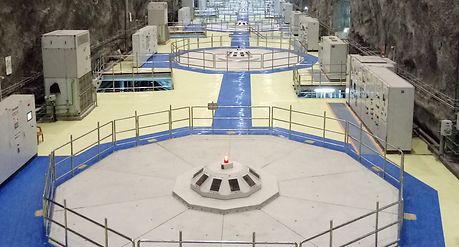Nepal - Moving on the right track
India - Best economic perspectives
India is a robust country with an area of 3.29 million km2 and a population of close to 1.4 billion people. It is currently the second most populous country after China and the population is projected to grow by about 1.4% in 2020. Projections also show that India might be the most populous country in the world by 2024.

India is both a regional and international economic power. However, from a GDP growth of about 6.4% in 2018, India has shown signs of recession. Currently, India’s growth is pegged at a relatively slow rate of 5.6% while forecast GDP by various multilateral agencies points to a figure of 5.1% for 2020.
India has over two thousand ethnic groups living within its boundaries. Importantly, more than 50% of India’s current population is below the age of 25 and over 65% of the population is below the age of 35. With this young population, India’s dependency ratio should be a little over 0.4, which means that it will be one of the most efficient and productive nations in the coming years.

Shivasamudram, Kaveri River, 42 MW; Commissioned in 1902, it is one of the oldest hydropower plants in Asia.
The hydro market outlook
The government of India made some amendments to the existing hydro policy in 2019. Namely, four major issues were addressed, including a Hydro Purchase Obligation limited to specific conditions, categorization of all hydro projects as renewable energy, rationalizing of hydro energy tariffs (incentives and tax rebates), and budgetary support for the cost of enabling infrastructure and flood moderation components.
To assist further development of the whole hydropower sector and create a robust business environment, the government set a target to raise the renewable energy capacity to 227 GW by 2022. As of October 2019, a total of 48 GW of renewable energy capacity had been installed in the country since March 2014.
Small hydro could contribute about 5 GW to the projected 175 GW of renewable energy capacity. The small hydro potential in India currently is 15,384 MW of which only 4,604 MW have been installed. Some 116 projects aggregating 553 MW are currently under construction.
Considerable growth is expected in Jammu and Kashmir, while the state of Himachal Pradesh has introduced changes in its state hydropower policy to attract developers with better co-ordination between Ministry of New and Renewable Energy and State Nodal agencies. It is also expected that projects in North Eastern states will be given due attention for geopolitical reasons. Currently, 1,662 MW of installed capacity is owned by private developers known as Independent Power Producers.

Teesta Stage III, Teesta River, 1,200 MW
Future outlook
With recent developments in Jammu and Kashmir, the government of India is looking to speed up strategically important hydropower projects in the state. These hydro projects, located mainly in the Chenab Valley, will be developed expeditiously due to geopolitical issues bearing from the existing Indus Water Treaty between India and Pakistan. Further, China’s One-Belt-One-Road policy has propelled the government to prioritize implementation of large projects like Ratle (850 MW), Dulhasti (390 MW), Kwar (600 MW) and Kiru (624 MW).
In Arunachal Pradesh, a hydropower potential-rich state with an untapped hydro potential of 50,328 MW, state-owned National Hydropower Corporation’s (NHPC) Dibang HEP (2,880 MW) witnessed some movement with recent Ministry of Environment, Forest & Climate Change clearance. In the southern states of Tamil Nadu and Karnataka, life extension initiatives for various aged hydro plants, which have an average lifespan of 55 years, are expected. Many are in dire need of renovation and modernization.
With the increase in variable renewable energy capacity, growth in hydro pumped storage schemes (PSPs) is also expected. Projects like Turga (1,000 MW), Lugu Pahar (1,500 MW), Kundah, which has already been tendered (500 MW), and a few larger-sized projects are expected to come up within the next few years.
Teesta-VI (600 MW) in Sikkim, which was previously being developed by an independent power producer, was finally resuscitated through NCLT and NHPC has taken over the project, but the funding is still open.
With the amendments to the hydro policy rolled out in 2019, a slew of projects are expected to come up for development by mid-2020.

Baglihar, Chenab River, 450 MW
ANDRITZ Hydro in India
ANDRITZ has been a leading player in the hydropower electro-mechanical sector in India and has supplied and installed equipment with over 18,000 MW capacity since the early 19th century. ANDRITZ is proudly associated with prestigious projects like Karcham Wangtoo (1,000 MW) and Teesta III (1,200 MW). Both projects were commissioned on time and have added substantial new capacity to the national grid. Additionally, ANDRITZ has been involved in service and rehabilitation of existing projects and small hydro projects.

Vertical generator test bench in ANDRITZ's manufacturing facility in Bhopal
With two well-established and state-of-the-art manufacturing sites, a new corporate office in New Delhi and an employee base of over 850 trained and qualified engineers, ANDRITZ Hydro in India is poised to be one of the largest units of the whole ANDRITZ GROUP outside Europe. ANDRITZ India is now aligned to address future market demand not only in India but across the whole South East Asia region.
In 2018, ANDRITZ further extended its portfolio by introducing its presence to the penstock and gates (PG) business for hydropower plants and irrigation projects. The company has also executed operation and maintenance (O&M) for hydropower plants and high capacity engineered pumps. Receiving the O&M contract for the Teesta III hydropower project in 2018, ANDRITZ further received contracts to maintain and service lift irrigation schemes in the states of Andhra Pradesh, Arunachal Pradesh and Telangana.
While continuing its dominance in the service and rehabilitation segment in India’s hydropower sector, ANDRITZ was recently awarded a contract from state owned Tamil Nadu Power Generation Company to renovate, modernize and uprate the Moyar hydroelectric project. The project, located in the Nilgiri Hills in western Tamil Nadu, has three units of 12 MW. Each unit will be uprated to 14 MW.

Teesta Low Dam Stage III, Teesta River, 132MW

Tiloth, Bagrathi River, 90 MW
The company has received a total of seven contracts for manufacturing, supplying and commissioning penstocks and gates for projects in Nepal and India. Very challenging commissioning schedules for all the projects mean the experience and expertise on hand are vital to allow ANDRITZ to meet client deadlines.
ANDRITZ Hydro India not only caters to the Asia market but has also exported equipment and generators to over 28 countries, including North America.
While it is pertinent to mention that there have not been many new large projects up for development recently, ANDRITZ is well prepared to contribute to the country’s hydropower sector and support the nation’s ambitious renewable energy targets.
General Facts
| Population: | 1.353 billion |
| Access to electricity: | 92.6% |
| Installed hydro capacity: | > 45,217 MW |
| Hydropower under construction: | 10,500 MW |
| Share of generation from hydropower: | 11% |
| Hydro generation per year: | 140,000 GWh |
| Technically feasible hydro generation potential per year: | 660,000 GWh |
| ANDRITZ Hydro: | |
| Total installed/ rehabilitated units: | 633 |
| Total installed/ rehabilitated capacity: | 18,076 MW |
| Location: | New Delhi, Bhopal, Prithla |
| Email: | contact-hydro.in@andritz.com |
Author: De Neelav Samrat




